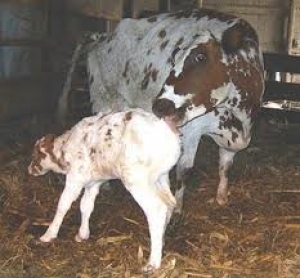Dairy Experts

Bluetongue primarily affects sheep, but also cattle and other ruminants. It is not dangerous to people, but it causes great economical damage.
Until a few years ago, the disease did not hit northern Europe. People assumed only tropical midges could transfer the responsible virus. Also, the virus did only replicate in the midges above 15°C, and often even higher. But in 2006 The Netherlands and Belgium were hit. Once the virus was present, local midges showed to be capable of transmitting it.
There are a lot of species called ‘biting midge’ (Cullicoides to biologists), and with classical tools it is almost unfeasible to differentiate them – there is a reason why they are popularly called no-see-ums. You have to put them under a microscope and measure minuscule details like the dimensions of the genitals. Work for specialists, and even then.
But if you don’t know which midges transmit the disease, you don’t know where it will spread, nor where you have to fight the midges – those little bugs there over that muck, should I be afraid or not? And if you want your pest control to be efficient and ecologically sound, you’ll have to know who’s the enemy, and who isn’t.
So the ITG researchers developed a simple and cheap molecular identification technology that identifies Cullicoides species in the lab with 100 per cent certainty.
They concentrated on the most important species in northern Europe, Culicoides obsoletus, C. scoticus, C. chiopterus and C. dewulfi, but they can reliably identify more than twenty species. Tests on larvae are very promising. Until now there is no way to differentiate larvae.
The scientists produced a ‘gene chip’ or micro-array, a glass slide to which short pieces of DNA are attached, that are characteristic for each species.
It costs quite some searching in the DNA to find those characteristic stretches, but once you have found them (in this case the ITS1 gene was used), you can attach them one next to the other on a glass slide. Such a slide can contain several dozens of different pieces of DNA, on well documented positions.
When you wash the gene chip with DNA from an unknown no-see-um – getting that DNA is a routine job in these modern times – identical pieces of DNA will recognise and stick to each other. This causes a blue colour reaction at that spot. With the naked eye one can recognise the characteristic pattern of spots for each species.
Contrary to other molecular identification tests, this one is very specific, and able to recognise several species at the same time. It certainly helps to determinate midges that are difficult to recognise under the microscope. And it works.
When the French CIRAD (Centre for International cooperation and Research for Agronomy and Development) sent out a ring test to see which labs could identify four species of biting midges with molecular methods, ITG was the only institute to identify all samples correctly, three times in a row.
The report is in the journal Medical and Veterinary Entomology.






















